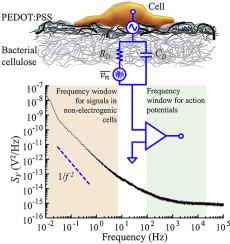Organic Electronics ( IF 2.7 ) Pub Date : 2020-07-03 , DOI: 10.1016/j.orgel.2020.105882 Pedro M.C. Inácio , Maria C.R. Medeiros , Tiago Carvalho , Rute C. Félix , Ana Mestre , Peter C. Hubbard , Quirina Ferreira , Jorge Morgado , Ana Charas , Carmen S.R. Freire , Fabio Biscarini , Deborah M. Power , Henrique L. Gomes

|
This study is focused on the particular advantages of organic-based devices to measure cells that do not generate action potentials, also known as non-electrogenic cells. While there is a vast literature about the application of organic conductors to measure neurons, cardiomyocytes and brain tissues, electrical measurements of non-electrogenic cells are rare. This is because non-electrogenic cells generate weak signals with frequencies below 1 Hz. Designing low noise devices in a millihertz frequency range is extremely challenging due to the intrinsic thermal and 1/f type noise generated by the sensing electrode. Here, we demonstrate that the coating of cellulose nanofibers with conducting PEDOT:PSS ink allows the fabrication of a nanostructured surface that establishes a low electrical double-layer resistance with liquid solutions. The low interfacial resistance combined with the large effective sensing area of PEDOT:PSS electrodes minimizes the thermal noise and lowers the amplitude detection limit of the sensor. The electrode noise decreases with frequency from 548 nV r.m.s at 0.1 Hz to a minimum of 6 nV r.m.s for frequencies higher than 100 Hz. This low noise makes it possible to measure low frequency bioelectrical communication signals, typical of non-electrogenic cells, that have until now been difficult to explore using metallic-based microelectrode arrays. The performance of the PEDOT:PSS-based electrodes is demonstrated by recording signals generated by populations of glioma cells with a signal-to-noise ratio as high as 140.
中文翻译:

细菌纤维素上的超低噪声PEDOT:PSS电极:一种用于访问非电源细胞中生物电信号的传感器
这项研究的重点是基于有机物的设备在测量不产生动作电位的细胞(也称为非电致细胞)方面的特殊优势。尽管有大量关于有机导体用于测量神经元,心肌细胞和脑组织的文献,但非电源细胞的电学测量却很少。这是因为非电性细胞会产生频率低于1 Hz的微弱信号。由于固有的热和1 / f,设计在兆赫兹频率范围内的低噪声器件极具挑战性感应电极产生的类型噪声。在这里,我们证明了用导电的PEDOT:PSS油墨涂覆纤维素纳米纤维可以制造出纳米结构的表面,该表面可以在液体溶液中形成低的双电层电阻。低界面电阻与PEDOT:PSS电极的大有效感应面积相结合,可将热噪声降至最低,并降低传感器的幅度检测极限。电极噪声随着频率的增加而从0.1 Hz的548 nV rms降低到高于100 Hz的频率的最低6 nV rms。这种低噪声使得测量低频生物电通信信号成为可能,这是非生电细胞的典型特征,迄今为止,使用基于金属的微电极阵列很难进行探测。PEDOT的性能:











































 京公网安备 11010802027423号
京公网安备 11010802027423号